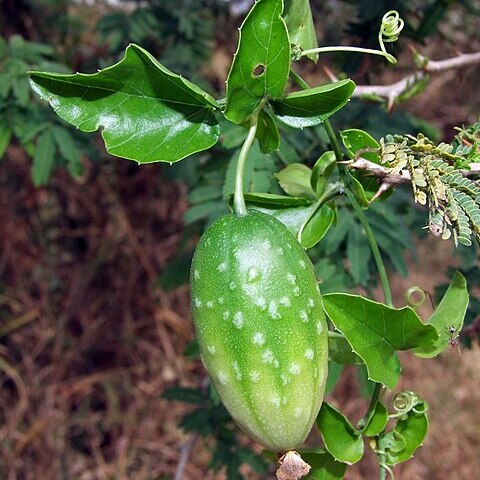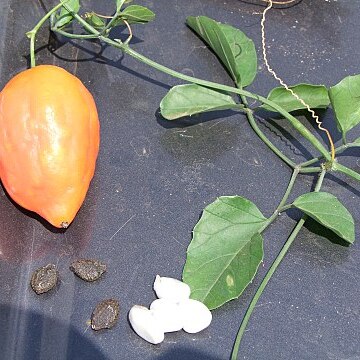male flowers solitary, or becoming fasciculate by reduction of leaves and internodes, pedunculate, bracteate; peduncle 0·6–8·0 cm. long; bract 1·5–7(16) mm. long, suborbicular, apiculate; pedicel 0·2–7 mm. long. Receptacle-tube 2–4 mm. long, lobes 3–7·5 mm. long, triangular or broadly ovate, obtuse or rounded. Petals 1·1–2·2 cm. long, yellow, dark at the base, obovate, rounded, apiculate.
A herb. It is a pumpkin family plant. It is a climber. The stems can be 6 m long. It keeps growing from year to year. Male and female flowers are on separate plants. The fruit are oval and bright red with paler spots. They are 4-6 cm long by 3-4 cm wide. The seeds are wrapped in white pulp. They are oval and 13 mm long by 7 mm wide and 4 mm thick.
Leaves compound, pedately 3–5(15)-foliolate; median leaflet 1·5–9 × 0·9–6·4 cm., ovate, weakly cordate, obscurely to distinctly sinuate and minutely denticulate, obtuse, apiculate, shortly setulose above; lateral leaflets smaller, somewhat unequal-based; petiolule of central leaflet 0·4–3·2 cm. long; petiole 0·4–2·2 cm. long.
Female flowers solitary, bracteate; bract small; peduncle and pedicel totalling 1·4–2·8 cm. long, the latter longer than the former; ovary 5–8 × 1·5–3·5 mm., cylindrical, glabrous; receptacle-tube obsolescent, lobes 3–4 mm. long, ovate-triangular; petals c. 1·2 cm. long.
Fruit 4–6·3 × 2·8–3·5 cm., ovoid, acute but not rostrate, terete or obscurely ribbed, bright red with paler spots, irregularly dehiscent; fruit-stalk 2–3 cm. long.
Stems prostrate or scandent, to 6 m., almost glabrous except at nodes, becoming thickened and pallid-barked when old, arising from woody subterranean tuber.
Seeds c. 13 × 7 × 3·5 mm., enveloped in slimy whitish pulp, ovate-rectangular in outline, with sculptured faces and grooved margins.
Flowers dioecious.
Tendrils simple.


